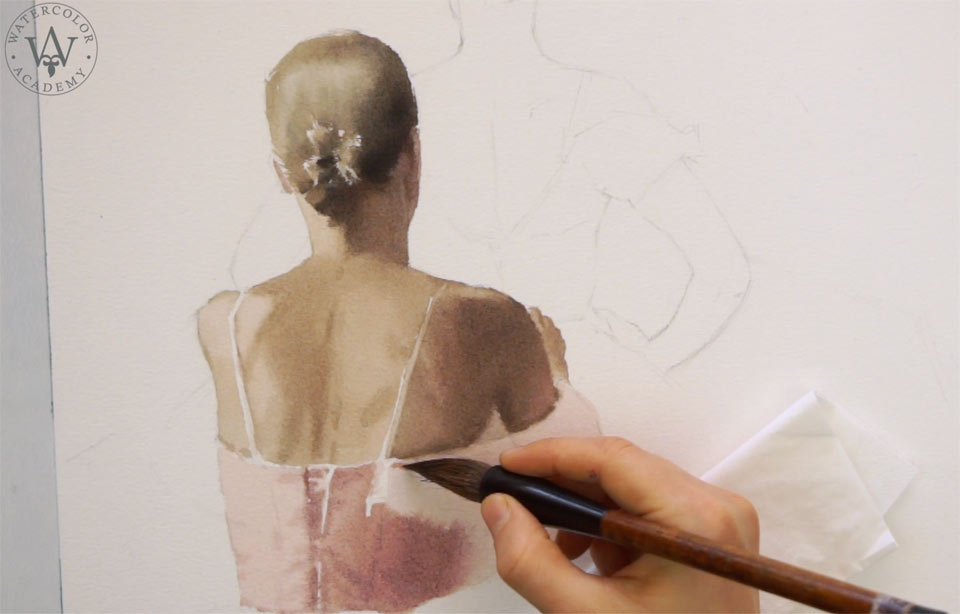Painting on Wet Un-stretched Paper
Article by Vladimir London, Watercolor Academy tutor
Instead of fixing paper mechanically with glue, pins or staples, you can paint on loose sheets without them becoming buckled

Painting by Anna Ivanova, Watercolor Academy tutor
The stretching methods described above are great for longer artwork when you plan to paint in multiple layers of washes and glazes, doing several sessions and letting paper dry and wetting it again many times.
However, if your preferred technique is fast wet-in-wet alla-prima then you will find the next method very helpful. Instead of fixing paper mechanically with glue, pins or staples, you can paint on loose sheets without them becoming buckled.
How to paint on un-stretched paper is demonstrated in multiple video lessons from the Watercolor Academy course
Before I describe this method, we need to agree on some terminology. I will use the following degrees of paper wetness from very wet to "bone-dry":
- Soaked
- Shiny
- Satin
- Moist
- Damp
- Dry
The method is based on the adhesiveness of wet paper to the smooth waterproof surface of a glass, a sheet of plastic or a rubber cutting matt.

Painting by Anna Ivanova, Watercolor Academy tutor
Here is how it works. You need a sheet of plastic bigger than the paper size. A cutting rubber matt works equally well. It can be fixed to a plywood board or an easel board with duct tape to be steadier. First, wet the plastic with a wide flat brush. The water will collect into drops; that's OK. Place the watercolor sheet working side down. Wet it with a flat brush, making sure no gaps are left dry. Turn the paper over and moisten its front side. Keep spreading the water, so there are no puddles left on top. Give it a few minutes to expand. It might buckle during this process. Lift one side of the paper sheet off the board and wet its backside with a flat brush once again. Slowly place the sheet on the board, pushing the excess water out by brushing the front side with a flat brush or a sponge. Do the same for other side as well.
When paper is shiny-wet with no puddles on top or under the sheet, let it dry for a few minutes. While drying, the paper surface will first become satin and then moist. Depending on your painting technique, you may want to begin painting wet-in-wet when the paper is satin to achieve soft gradations of washes or diffused brushstroke edges, or wait until the paper is moist to have more control over brushstrokes.
While painting, keep an eye on paper wetness. Moist paper has a matt surface but feels cold as the water evaporates. It will stick to the plastic board, keeping the paper surface flat because there is moisture between the sheet and the board.
From time to time during the painting process, you may wet the paper slightly using an atomizer or lift the sheet from one side and wet the backside with a flat brush and then repeat from the other side. Under normal humidity levels, the paper will stay moist for about an hour or longer, giving you plenty of time to paint before re-wetting the backside of the paper.
To prolong drying time, you can use a thin, wet piece of cloth. This would preferably be a butter-muslin, as they can hold drops of water between their threads. The piece of cloth has to be slightly bigger than the paper size.
Of course, the paper will eventually dry and may curl or buckle. When artwork is thoroughly dry, you can place it under a weight overnight to flatten it.
There are many techniques that can be used to paint on un-stretched satin or moist paper, including wet-in-wet washes, dry-brush on moist, wiping out, stippling, etc. Different painting methods and techniques are fully demonstrated in the numerous Watercolor Academy video lessons.
To learn how to paint in watercolor, enroll now
Watercolor Academy Online Course
A self-study, self-paced course where you can learn how to paint in watercolor by watching video lessons and doing assignments
- Unlimited access to 80 watercolor painting video lessons
- Lifetime membership without deadlines
- Unlimited support from the Academy tutors
- Constructive critique of your artworks
- Member access to the Academy's Art community
- Place in the Academy's Students Gallery
- Exclusive members-only newsletter and bonuses
- Watercolor Academy Diploma of Excellence in your name
One-time payment - Lifetime membership
$297 USD
ENROLL NOW
Personal Tutoring online + Online Course
One-to-one, unlimited and custom-tailored to your skills and needs Personal Tutoring by the Watercolor Academy teachers
- Everything in Online Course, plus:
- Dedicated team of art tutors
- Assessment of your current level of art skills
- Personalized curriculum tailored to your skills and goals
- Up to 100 art tasks with by-task assessment
- Unlimited one-to-one personal coaching with detailed per-task instructions and feedback
- Artwork critiques and results-oriented guidance
One-time payment - Lifetime membership
$997 USD
ENROLL NOW






